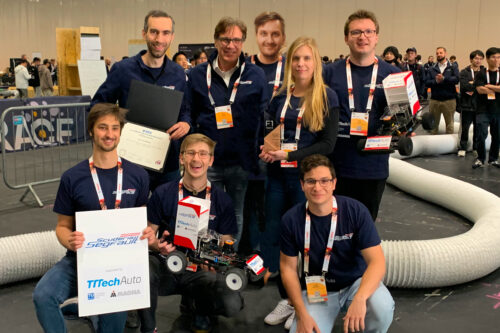After three thrilling competition days, team Scuderia Segfault from TU Wien secured Silver at the 11th F1Tenth Autonomous GPRX. This competition with 41 registered teams from universities and research institutes from all over the world took place at IEEE International Conference on Robotics and Automation (ICRA) 2023 from May 29th – May 31th 2023 in London, UK. This win follows Gold of TUW Fast and Furious at the 8th F1Tenth Autonomous GPRX at IFAC Berlin 2020, Gold of Scuderia Segfault at the 9th F1Tenth Autonomous GPRX in Prague 2021, and Bronze of Scuderia Segfault at the 10th F1Tenth Autonomous GPRX in Philadelphia 2023, making it the Fourth podium placement in a row.
The competition is a race format of fully autonomous 1/10th-scale F1 Race Cars, which compete against each other to finish first on a given race track. To solve this challenge, each team needs to implement advanced autonomous software and algorithms to find the perfect race line while simultaneously avoiding colliding with other cars. Countless hours of preparation and hard work were invested by the team members Moritz Christamentl, Felix Resch, Fabian Kresse, Agnes Poks, Philipp Mandl, and Luigi Berducci. The team was supervised by Andreas Brandstätter and Radu Grosu from the Research Unit for Cyber-Physical Systems.
LIDAR woes and track hurdles: A race against time
When arriving in London, open training commenced in the afternoon of the first day. The cars needed to be prepared to record a map on the track and find an optimized race line using advanced algorithms. At this point, it did not go smoothly for Scuderia Segfault, as the LIDAR of both cars was randomly dropping measurement packets, making the cars drive blindly. The team needed to adapt the racing software overnight to get the car properly running on the very narrow and challenging track.
The next day, the time trials showed that the team’s modifications were right. Using an adaptive model-predictive-control approach, the team scored the second-fastest lap time overall. This was an exceptional time of just 12.83 seconds to complete a full lap. However, the car’s stability was still an issue that needed careful further adaptions for the upcoming races. It even got more difficult, as after an oil spill by another car the traction conditions changed. So the second run of the time trials did not go very well. To top it all off, severe LIDAR problems still persisted. These caused spurious crashes and it was clear, that this urgently needed to be resolved in order to retain a chance for a top placement. So the team mobilized all problem-solving capabilities, replaced the hardware components overnight, and tried different approaches of software modifications to address this issue.
Nerve-wracking races
The hard work paid off, as the car was finally able to drive in a reliable manner on the final day of head-to-head races. The team could secure a clear win against the first opponent, team HUMDA-SZE 2. The next race was against team HiPeRT Modena from the University of Modena e Reggio Emilia. Based on the lap times of previous runs it was clear that this was an extraordinarily fast and stable car. So the team needed to speed up to retain a chance. Every single parameter was carefully adjusted, to get a faster lap time. But at the same time, the team needed to keep a balanced behavior not risking too much and potentially causing a fatal crash. The first heat was won by HiPeRT very closely. Even more, tuning was necessary for the next run. The team took full risk and got into the tie-breaking race. It was absolutely nerve-wracking when TU Wien’s car passed the finish line just centimeters before HiPeRT. The semi-final was against team Suzlab from Nagoya University, Japan and it brought a clear result, advancing TU Wien to the grand final.
The Grand Final Race was against team ForzaETH from ETH Zürich, whom our team was able to defeat last year in the Small Final. This year it was their term to win: with a great hardware platform and an improved but conservative version of their previous year’s pure-pursuit / follow-the-gap control software. Our team took a daring leap in software, trying out an adaptive model-predictive control. ETH’s team was faster in the end, taking a deserved win. Alas, Scuderia Segfault has their eyes fixed on the next race!
The TUW Scuderia Segfault Team thanks TTTech Auto for their generous support that made participation in this race possible. They also thank Magna International for their financial support of the team.











